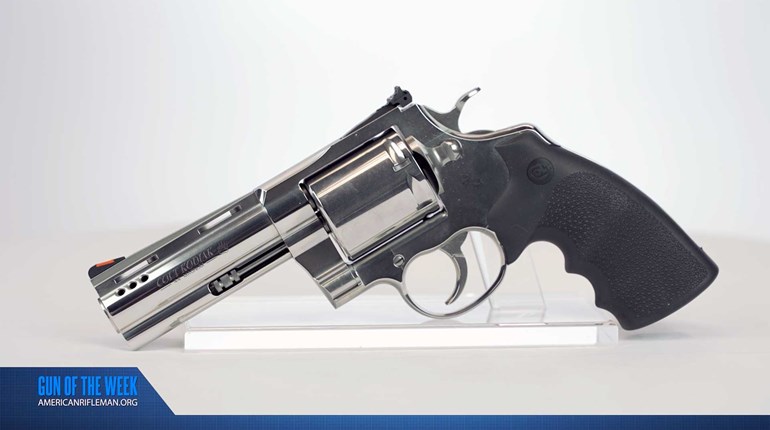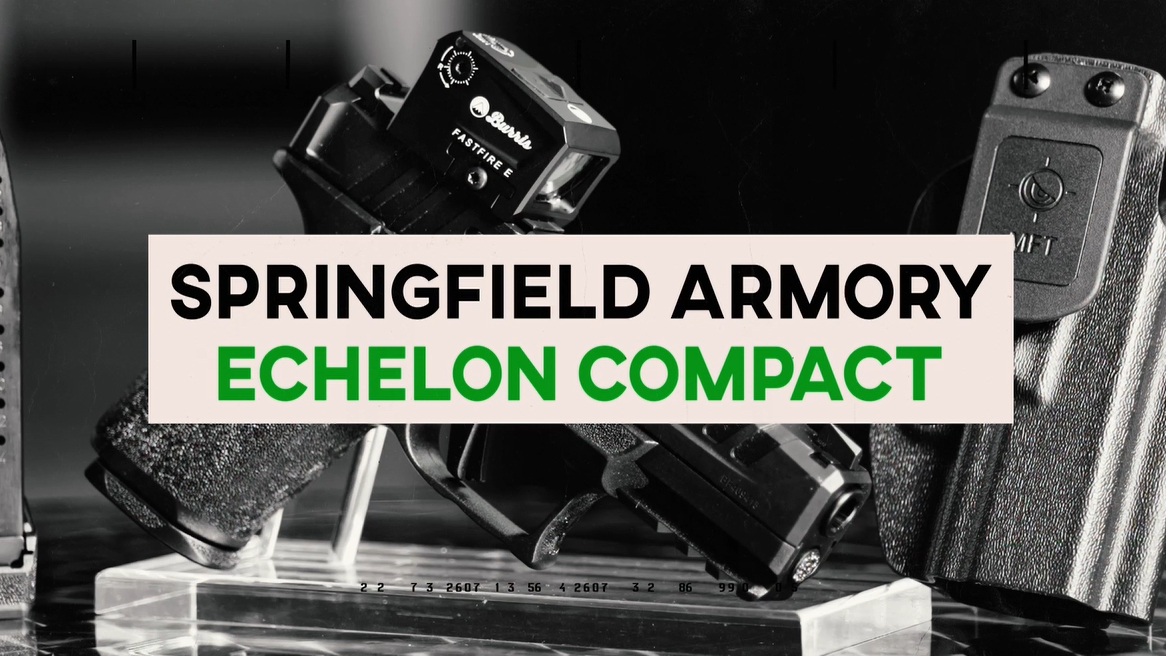
The Colt Cobra revolver is shown above, along with a Safariland Comp II speedloader, Al Mar SERE 2000 folding knife, LA Police Gear Operator Mini EDC flashlight, Galco Gunleather holster and an NRA Carry Guard insurance card.
There’s nothing on record I’ve seen that suggests Sam Colt ever strapped on a pair of his revolvers and headed west to tame one of the tough frontier towns like Tombstone or Dodge City. Not that he didn’t participate. From the mid-19th century (including our civil war) up to World War I, Colt revolvers were almost mandatory issue for the intrepid adventurers who put their shooting skills to work taming the Old West or subduing any behavior they considered hostile.
Moving forward through the first 3/4 of the 20th century, vast numbers of lawmen and civilians alike carried the new Colt double-action revolvers manufactured at the iconic company’s Hartford facility. No change in purpose: the newer revolvers were still used to correct unacceptably rude behavior. Despite the massive changeover to semi-auto pistols by law enforcement agencies around the 1970s, Colt continued providing double-action revolvers to private citizens (and backup guns for cops) until the new millennium when the company finally phased out production of the classic wheelgun. But, as the little girl said in “Poltergeist,” “They’re back!”
Recognizing that there is a strong demand for small revolvers in the self-defense market, Colt has redesigned and is now producing a newer (and much better) version of its Cobra revolver. It has a stainless steel frame rather than lightweight aluminum and a shrouded ejector rod, but it still has a hammer that allows both single-action and double-action firing, a push-to-the- rear cylinder-release latch and holds six rounds of .38 Spl.
In keeping with today’s modern ammo, the new Colt Cobra is rated for +P loads. It was obvious to me that a couple of trips to the range for velocity measurements and group testing simply wouldn’t be enough. Properly attired in a Galco leather belt and holster (Model B179,) I took the newest serpent to Gunsite Academy for one of the school’s five-day classes. While initial looks from some of the other students suggested that perhaps I should have worn a loin cloth and carried a club, we all ended up pleasantly surprised by the little revolver’s thoroughly modern performance.

The Colt Cobra is larger than the typical J-frame five-shot revolvers but still quite compact. It will fit in a box 7.2 inches x 4.9 inches x 1.4 inches. You could shrink the height and width a bit by replacing the Hogue grips with a smaller set of panels, but to me that would be a bad trade. While reduced dimensions might allow the gun to fit in a trouser pocket, the revolver’s empty weight of 25 ounces is more than double that of some five-shot competitors making pocket carry dubious depending on your wardrobe and lifestyle. We’ll come back to carry techniques and potential missions later.
The new Colt Cobra has an attractive matte, satin finish, and while looks may be irrelevant in a self-defense handgun, the finish looked about the same after five days and perhaps 400-500 rounds fired without any cleaning. The Hogue rubber grips fit me perfectly, which helped absorb recoil and made the little six-shooter almost as easy to shoot well as a service/duty-sized gun. The plastic Cobra box contained an interesting trigger profile graph, which I didn’t find particularly interesting because I didn’t understand all of it. Doesn’t matter, because just dry firing the Cobra double-action convinced me it had a superb trigger.
After a couple days on the square range, I took another look at the graph. It says that within the first .05 inch of travel, trigger pressure rises to just under 7 pounds and then smoothly increases another pound or so before the hammer falls after a total of .5 inch of travel. While the chart presents the facts, it doesn’t prepare you for just how great the Cobra’s trigger is. The trigger guard is enlarged behind the trigger to allow for the use of gloves, but since May in Arizona doesn’t normally require gloves, I can’t speak to that. All shooting drills at Gunsite were done with the Colt Cobra carried strong side in the OWB Galco holster covered by a loose shirt.
The Colt Cobra’s rear sight is simply a 1⁄8-inch-wide notch in the rear end of the topstrap. It will not be adjusted either by you or by any hard object you might crash into. The front sight is a replaceable blade, and the test gun was in current vogue featuring a black blade with a red fiber-optic insert. The whole sight is replaceable because Colt anticipates offering other options up front such as a night sight or a plain-black post.
Throughout the close-range drills, the front sight was superb. With any reasonable level of ambient light, the red optic almost forces the shooter to focus on it, and with the Cobra’s excellent ergonomics, the gun seemed to emerge from the holster with the red fiber pipe properly located in the rear notch and centered on the target. For my eyes, the rear sight could be a bit wider.

Against a dark back ground, even in relatively bright daylight I could not see any light around the sides of the front sight blade, so I had no ability to judge windage. Such was not a problem inside 20 to 25 yards; if the red fiber is visible and on target, simply press that incredibly smooth double-action trigger for consistent hits. During the class-elimination drills, I exited the contest at 25 yards for being unable to make a hit on a dark-blue, steel target. Inside 20 yards, the Colt Cobra and I were near the top of my class in dealing with the dancing robot, the poppers and/or paper felons hiding in a crowded environment.
As mentioned above, the ejector rod is protected by a shroud that is integral to the barrel. Good thing, since a bent ejector rod can really ruin your day in an armed confrontation. As on other “pocket revolvers,” the ejector rod is, by necessity, quite short with less than an inch of full travel.

When fully pressed, the .38 Spl. cases are still partially enclosed in the cylinder’s chambers. There’s good news and bad news here. Good news is that for a tactical or partial reload, a full-length stroke on the rod with the muzzle pointed downward leaves the fired cases sticking out of the chamber almost an inch while the unfired cases drop back into their chambers. It’s considerably easier plucking those empties from the Colt Cobra with that much case exposed. The bad news is that you really need to practice your speed loads, i.e. keeping the muzzle elevated when stroking the ejector rod, allowing gravity to help the empties drop clear of the weapon and ensure an empty case doesn’t drop back into its chamber beneath the extractor. It isn’t difficult to master, but without practice, you probably won’t do it correctly under the extreme pressure of a fight.
I don’t usually look forward to range visits with a pocket pistol when the objective is to perform the protocol tests. Firing through a chronograph or from a rest to test groups can be enlightening, but it is also usually boring and sometimes painful. It was not until after the five-day class at Gunsite that I took the still-uncleaned Colt Cobra to my home range for the basic data gathering. Having fired a few hundred rounds at the Academy, I was pretty relaxed and comfortable arranging the sandbags and erecting the chronograph.
Because of my experience with the sights at the class, and because 2-inch revolvers are generally selected for short-range encounters, I set the distance at 15 yards. At Gunsite, I used Cor-Bon’s 147-grain FMJ .38 Spl. ammo. It has a small meplat (flat nose), which in my opinion, means it could be used for both training and defensive purposes. As it turned out, I had enough left to take some velocity measurements but not for the full-protocol accuracy tests. At 783 fps, the Cor-Bon’s velocity was exactly in the middle of all ammo tested through the Colt Cobra. Selection of other ammo was based on including as many “known” .38 Spl. preferences as possible.

Both the Remington wadcutters and lead round nose bullets demanded a seat at the table based upon historical usage. I’ve used the lighter-weight Hornady .38 Spl. loads before and been pleased with them, particularly in small revolvers. They are designed specifically for defensive use in short-barreled, light guns and are very manageable. In addition, they are “friendly” enough in popular, lightweight revolvers to encourage practice sessions, the most basic ingredient for competence.
But it was the Super Vel ammo that sparked a real romance and swept the little Colt Cobra across the dance floor. With an average muzzle velocity of 1,260 fps, it smoked the competition. Perhaps even more importantly, it was totally comfortable and controllable to shoot, something I attribute to the Hogue grips and the 25-ounce weight of the stainless steel gun. The Super Vel didn’t produce the single smallest group of the day, (that was a string of Remington wadcutters, which somehow seems fitting after a decades-long reputation as the accuracy load for .38 Spl.,) but it did produce the smallest average five-shot groups for five strings. The new Super Vel .38 Spl. loads are absolutely my first choice of ammunition for the Cobra. It’s like an upgrade to .357 Mag. power without the pain.
There was not one malfunction during the five days at Gunsite or later, when I shot the Colt Cobra at my home range.

So what is the niche that Colt’s new Cobra could fulfill in today’s self-defense market? Its six-shot frame equipped with the oversize Hogue grips appears large for a trouser pocket pistol, clearly too big for all the jeans and most of the casual trousers I have, but it should carry well in a coat jacket pocket or ankle holster. I carried it for a week in the Galco belt holster and felt both physically and psychologically comfortable. Perhaps a purse or pouch carry technique might be best: manageable weight with no tell-tale bulge.
But to me, new shooters—especially those who are a bit intimidated or confused by the required manual-of-arms that must be mastered by the user of semi-automatic pistols—may benefit most from Colt’s return to wheelguns. There are two members of my family who much prefer the simplicity of revolvers, and the new Colt Cobra is a superior choice to the revolvers selected by my family crew. Think about the Cobra’s “not too heavy, not too light” 25 ounces, the excellent ergonomics and grips that mitigate recoil, and the gun’s incredibly consistent trigger. This is a revolver that can easily serve as a house gun, car gun or carry gun. Please don’t tell me there’s no room for a new, compact revolver.








































